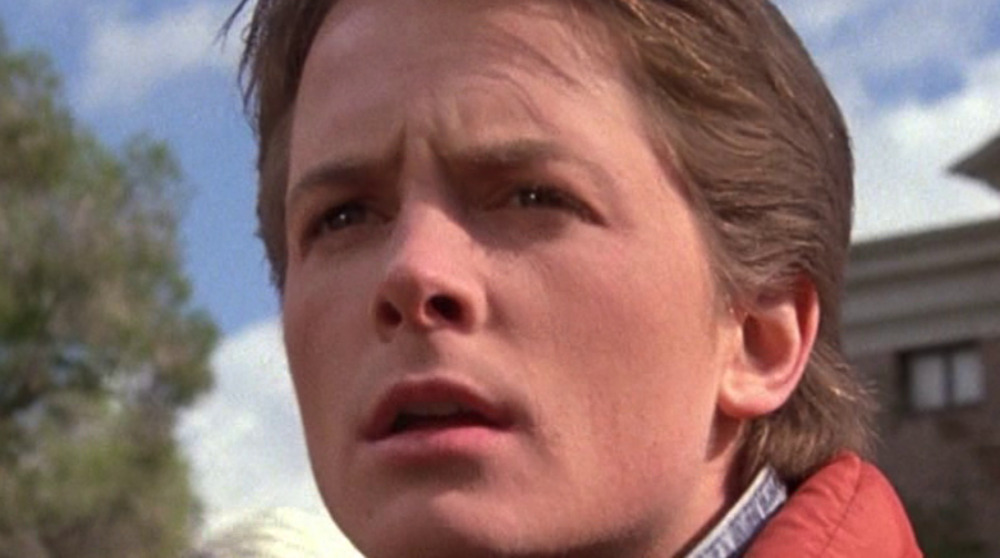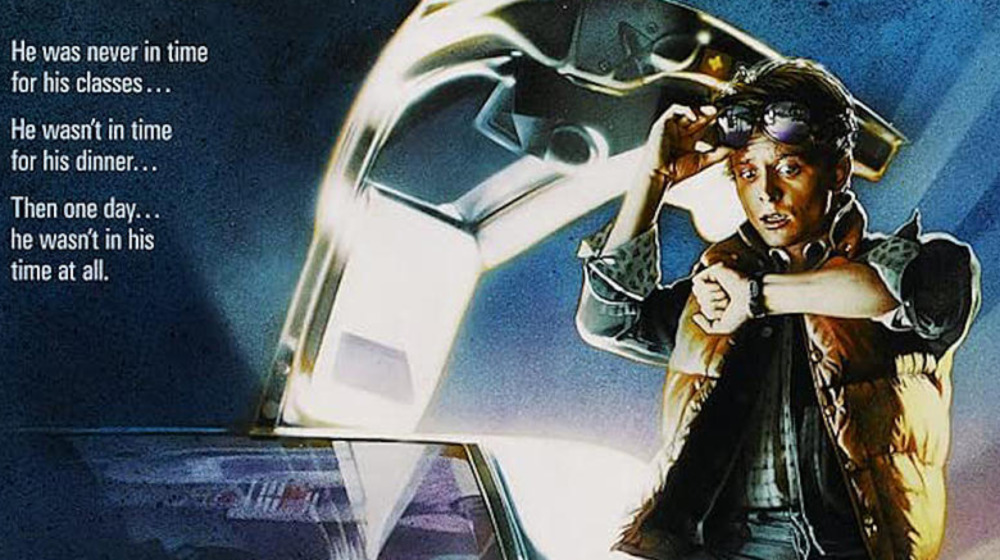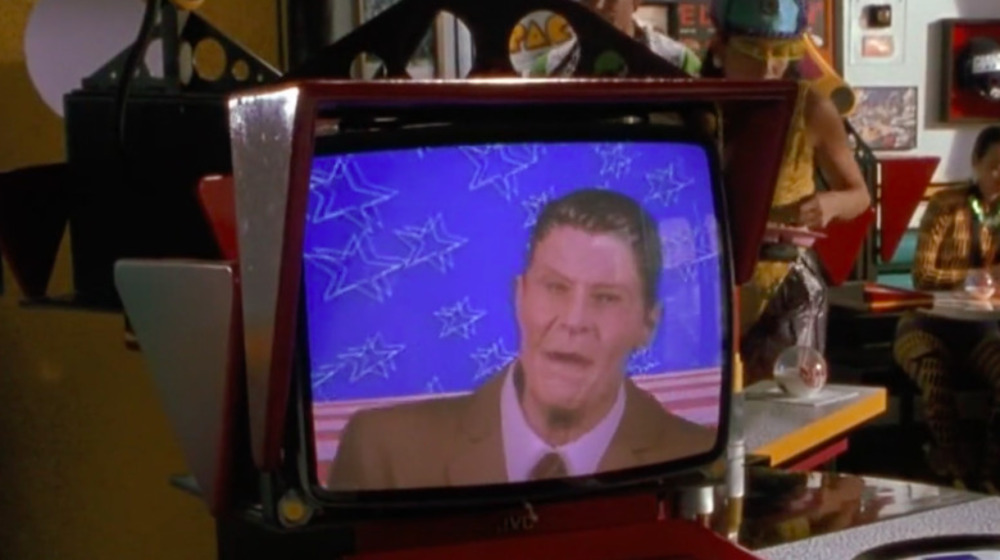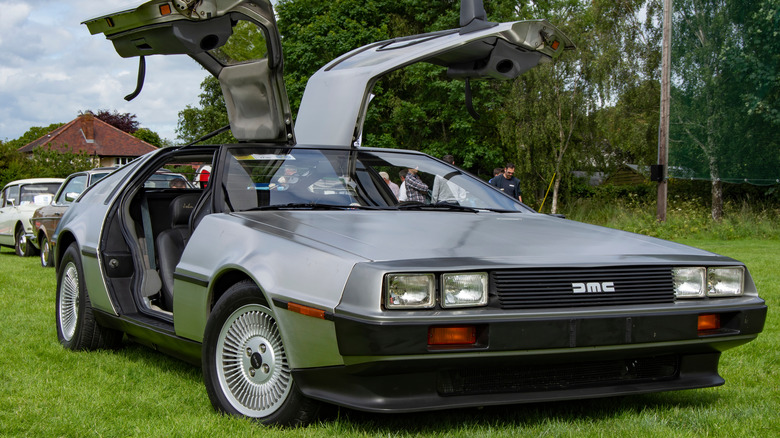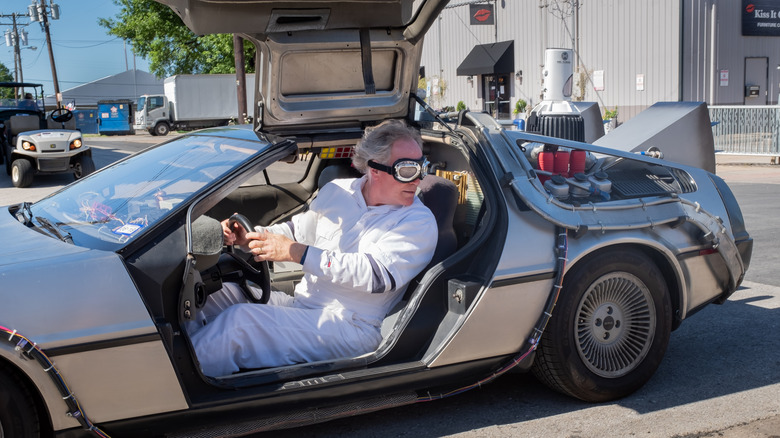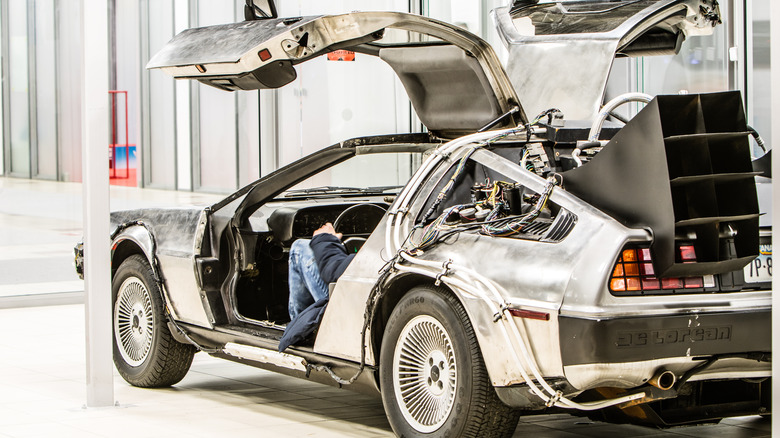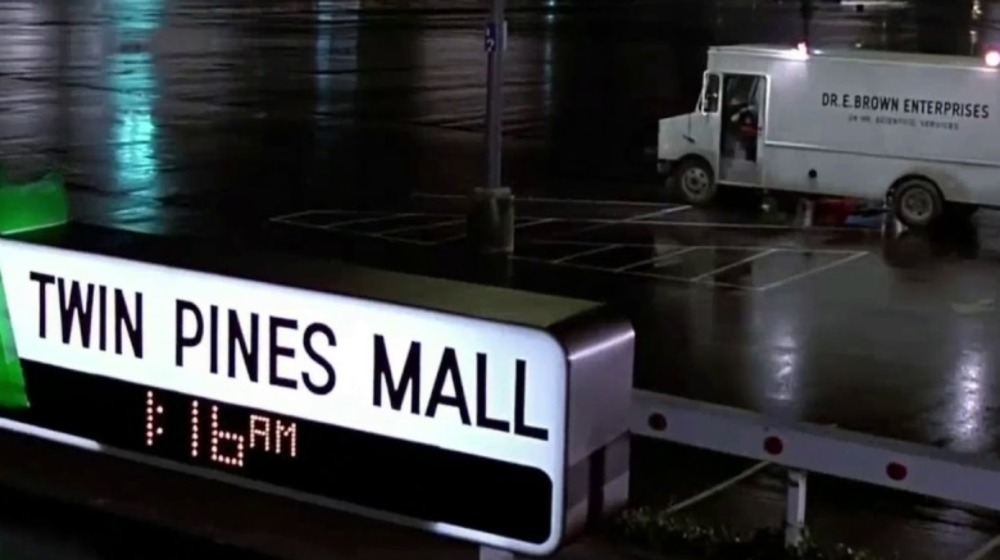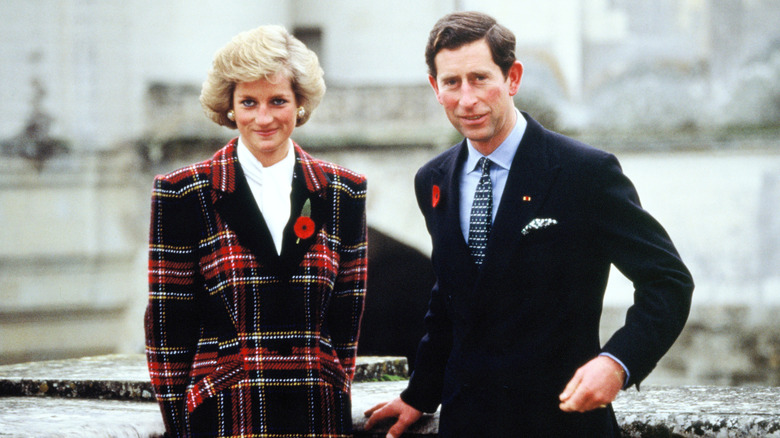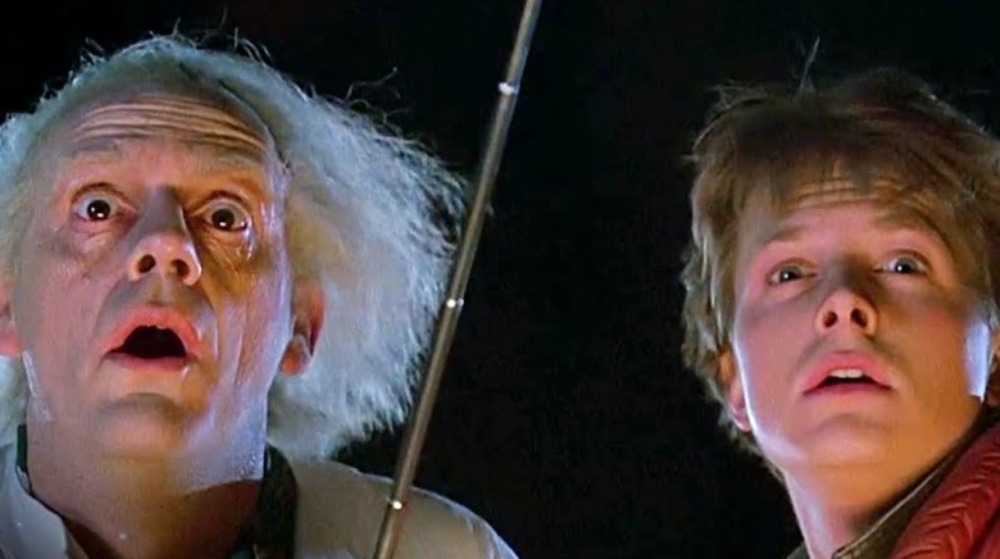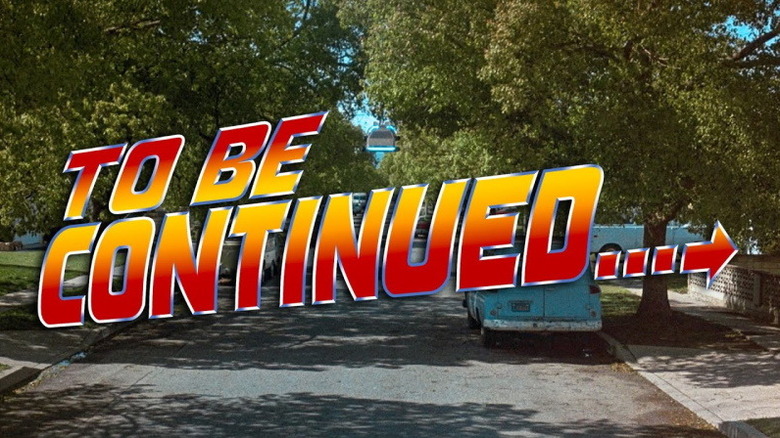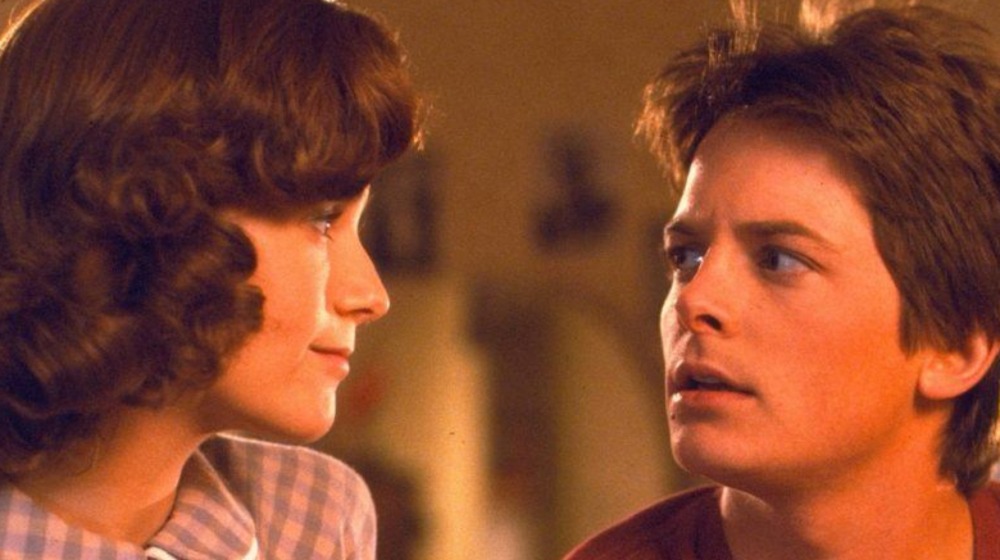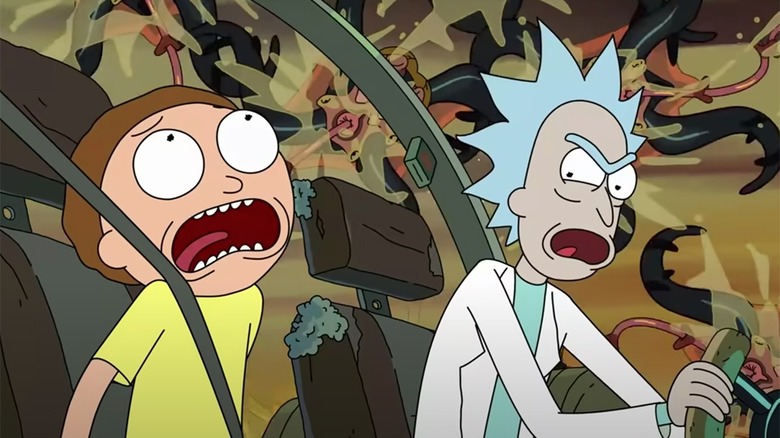What It Was Really Like To See Back To The Future In 1985
On Wednesday, July 3, 1985, audiences got to see the first official screening of a movie that would launch a cultural phenomenon. Today, Robert Zemeckis and Bob Gale's time travel comedy Back to the Future has influenced a multi-media franchise of films, comic books, theme park rides, video games, and even a retro-flashback band, The Flux-Capacitors.
In retrospect, it's easy to see why the film connected with so many people. By weaving together sci-fi, comedy, nostalgia, and romance, Zemeckis and Gale drew multiple audiences into the tale of teenager Marty McFly (Michael J. Fox) who traveled back to the year 1955 where he met his parents as teenagers and accidentally prevented them from meeting. As Marty's friend Doc Brown (Christopher Lloyd) worked to get Marty home, Marty had to get his parents to fall in love so he had a future to return to.
But back in 1985, nobody knew what effect the film would have on future generations. In fact, test audiences didn't know the film was a comedy, much less a future classic. But soon families, collectors, and even political figures all found themselves part of a massive pop culture event that stretched from the White House all the way to Britain's Royal Family.
Let's take a look back in time to see what it was really like to watch Back to the Future in 1985 — and witness the beginning of what is considered to be one of the great film experiences of all time.
Critics loved the movie
Some films take a while to find their audience. Even movies that are later considered classics don't always receive a warm reception at the box office or enjoy favorable reviews when they first come out.
But not Back to the Future. From the start, film reviewers from major publications like The New York Times and Variety all gave the movie glowing reviews. Some, like Newsweek's Jack Kroll called the film, "the smartest, sweetest, funniest comedy in many summers." Others, like Empire's Adam Smith, praised the screenplay, calling it a "near perfect script" — an observation that would be echoed in film classes for decades.
Film critic Roger Ebert was particularly complimentary, giving the film 3 ½ out of 4 stars. In his review, Ebert compared the film to Capra's It's a Wonderful Life (1946), praising the hopeful way it allowed audiences to see their parents in a new light. Director Robert Zemeckis also received accolades from the legendary critic, with Ebert stating his touch gave the film "charm, brains, and a lot of laughter."
Considering Zemeckis and Gale's project was turned down 40 times by multiple studios before being made, the warm critical reception to Back to the Future had to be extremely gratifying.
The film caused some tension at Camp David
One of the funniest moments from Back to the Future came when the Doc Brown of 1955 asked Marty who the President of the United States was in 1985 — and then reacted with disbelief when he learned actor Ronald Reagan would become President Reagan in the future. According to former Reagan speechwriter Mark Weinberg, Reagan, who viewed the film for the first time at Camp David, "got a kick" out of an early scene where Marty walked by a 1955 movie theater advertising the Reagan film, Cattle Queen of Montana (1954).
When Doc had his famous exchange with Marty, however, the mood at Camp David darkened — not because of Doc's comment about Reagan, but because the character later sarcastically asked: "I suppose Jane Wyman is the first lady?" Wyman was Reagan's first wife, whom he divorced in 1949. By 1955, Regan was married to future First Lady Nancy Reagan, but Doc (and the screenplay) completely ignored that fact.
Weinberg recalled that there was an "unspoken ban" on mentioning Wyman among the Reagan staff and that, "It was as if [Reagan] had willed himself to forget about that period of his life, and was startled and resentful when asked to return to it." Fortunately, the discomfort was only momentary, and Reagan never commented publicly on Doc's faulty reference.
Ronald Reagan became a fan of the film
Despite his brief discomfort at the mention of ex-wife Jane Wyman by Doc Brown, President Ronald Reagan became a big fan of Back to the Future.
His speechwriter Weinberg would later recall that both Ronald and Nancy Reagan were impressed by Michael J. Fox's performance as Marty McFly. This may have been related to the fact that Fox was also playing Republican teenager Alex Keaton on the Reagans' favorite television show at the time, Family Ties.
Regardless, actor-turned-politician Reagan commented at the time on how "clever" the movie was. Weinberg said that Reagan remarked that "this was the type of movie that Hollywood should be making, as opposed to some of the more controversial, violent or adult-themed films that seemed all too common at the time."
Six months later, President Reagan even quoted Back to the Future in his February 4, 1986 State of the Union address. Encouraging the American people to look to the skies as the limit to their achievements, Reagan stated, "As they said in the film Back to the Future, 'Where we're going, we don't need roads."
The producers got a fan letter from the inventor of the DeLorean
Zemeckis and Gale ultimately chose to use a DeLorean as the basis for their time machine, partly because the gull wing doors of the car would allow a 1955 family to mistake the vehicle for an alien spacecraft when Marty crashes into their barn. Although Ford offered the production team money if they made the time machine out of a Mustang, Bob Gale reportedly responded, "Doc Brown doesn't drive a [censored] Mustang."
The time machine's stylish and memorable design earned the filmmakers praise from the sports car's original designer — John DeLorean. By 1982, the DeLorean Motor Company (DMC) had gone bankrupt and its factory closed. This ended DeLorean's dream of creating an "ethical sports car," with the inventor later getting tangled up in a cocaine sting, although he was eventually acquitted.
Thanks to Back to the Future, however, the DeLorean DMC-12's image was immortalized. Realizing the movie had kept his dream alive, John DeLorean sent the filmmakers a fan letter thanking them for using his car.
The movie started a DeLorean collecting craze
In the Back to the Future documentary Back in Time (2015), many original viewers of the film admit that when they first saw the movie, they assumed the cool sports car Doc Brown built his time machine out of was invented specifically for the movie. When they discovered that the car was a real-life DeLorean that was now in short supply, moviegoers began battling to get the car for themselves.
This fueled a major DeLorean collecting craze that persists to this day. Reportedly, the DeLorean Motor Company only managed to produce over 9000 DeLoreans before the company went bankrupt in 1982. However, thanks in part to Back to the Future, an estimated 6500 DeLorean cars are still on the road today. This is in sharp contrast to other discontinued car models, which normally phase out of existence once they stop being made.
Ironically, in 1984, former DeLorean dealer Steve Lopinto claimed the car "doesn't have enough mystique to become a collector's car." Flash forward to 2011 when someone purchased an original Back to the Future DeLorean for $541,000. Thankfully, other DeLorean cars are more affordable — a 1981 DMC-12 went for $23,100 at an auction in 2019.
Fans began building their own time machines
Of course, many DeLorean car collectors don't just want a classic sports car — they want the time machine from Back to the Future. This led many fans to modify their DeLoreans and make them resemble Doc Brown's iconic design.
Among these builders are Oliver and Terry Holler, who spent three and a half months refitting a DeLorean sports car with scrap metal and surplus electronics to recreate the Back to the Future time machine. Today, the Hollers volunteer for the Michael J. Fox Foundation for Parkinson's Research and drive their DeLorean around the country, raising money and awareness for Parkinson's research.
In other cases, fan enthusiasm allows them to get close to the actual DeLorean from the movie. In the documentary Back in Time, fan Joe Walser recalled that he promised he would buy a DeLorean and turn it into a time machine. Today, Walser is on the Time Machine Restoration Team and helped restore one of the original DeLorean time machines after it fell into disrepair on the Universal Studios Movie Lot.
People gathered at Twin Pines Mall on October 26, 1985 to see if Marty McFly would show up
If you look closely at the dates on Doc Brown's time machine, you'll see that Marty McFly first drove Doc's time traveling DeLorean on October 26, 1985 in the parking lot of Twin Pines Mall (actually Puente Hills Mall in City of Industry, California). However, Back to the Future was released to the public on July 3, 1985, almost four months before the film's events took place.
This led a group of fans to show up at Puente Hills Mall on October 26, 1985, to see if Marty or Doc Brown would appear in the famous DeLorean. Unfortunately, neither character made a real-life appearance — but that didn't stop another group of fans from showing up at the Puente Hills Mall on October 26, 2015 to see if Doc or Marty would show up 30 years later. This time, the owner of a DeLorean time machine replica did show up, giving fans a fun photo op.
(Incidentally, in Back to the Future Part II, Doc Brown travelled forward to the date October 21, 2015 — so the fans may have arrived a bit too late to see the good doctor arrive in his flying DeLorean).
Michael J. Fox had an uncomfortable time watching the film with the British Royal family
In the documentary Back in Time, Michael J. Fox recalled that during the 1985 world premiere of Back to the Future, he was seated next to none other than Princess Diana who was attending the premiere with her then-husband Prince Charles. Prior to the screening, Fox and the other attendees received a list of rules for how they should interact with British royalty. Among them, they were forbidden from turning their backs on the prince or princess and could not speak unless spoken to.
Unfortunately, shortly after the movie began, Fox realized he had to go to the bathroom and found himself in an uncomfortable position. He couldn't walk away from Princess Diana without turning his back on her and he couldn't excuse himself since he was instructed not to speak to her. Unable to see any way out of the situation, Fox simply sat in agonizing pain for the nearly 2-hour long movie.
Even so, Fox managed to laugh about his pseudo date with Princess Diana, later telling interviewers the famous princess was "smokin' hot."
Test audiences didn't know the movie was a comedy
Before Back to the Future was officially released on July 3, 1985, a test audience got to see the film when it first screened in May of 1985 at the Century Domes Theater Complex in San Jose, California. Some audience members, like 18-year-old Martin Sanchez who recalled his experience in the documentary Back in Time, won tickets from an MTV contest.
Unlike a premiere, there were no signs or hints about what the movie would be about. People did get excited when the opening credits revealed the film was created by Steven Spielberg and Robert Zemeckis, but many still had no idea what to expect. As a result, when Doc Brown sent his dog Einstein forward in time one minute and made him vanish, Bob Gale recalled years later that some audience members were distressed because they thought the dog had been killed. However, once Marty traveled to 1955 and met his teenage father, the story clicked with the audience, who immersed themselves in the story.
To Be Continued... didn't appear at the end of original screenings
Today, when people think of Back to the Future, they think of the entire trilogy. To a contemporary audience, it appears that Zemeckis and Gale always planned the story to be an epic three-part tale. After all, the infamous words, "To Be Continued..." do appear at the end of the first movie.
Except that, for audiences who saw the film in 1985, they didn't. The original film did indeed end with Doc Brown taking Marty and his girlfriend Jennifer Parker (Claudia Wells) to the future, but both Zemeckis and Gale nevertheless envisioned the movie as a standalone. However, when the film became a huge hit, the studio put pressure on the filmmakers to continue the story.
As a result, when Back to the Future was released on home video in 1986, MCA/Universal added the words, "To Be Continued..." at the end. This helped build anticipation among fans as well as new audiences who saw the film for the first time on VHS tape — which was helpful, since Back to the Future Part II wouldn't hit theaters until 1989. In 2002, the "To Be Continued..." ending was removed again when the Back to the Future trilogy was released as a DVD box set.
The 'incest' comedy proved popular with at least one audience member
Back to the Future might be considered a sweet comedy by many fans, but it does have some uncomfortable moments — particularly the scenes between Marty McFly and his teenage mother Lorraine Baines (Lea Thompson). After getting hit by the car that was supposed to strike his father, Marty fell under Lorraine's care while she experienced a case of "The Florence Nightingale Effect," falling for the teenager while unaware that he's her own son.
It was this subplot that caused the movie to be turned down by Disney when Zemeckis and Gale were looking for a studio to produce the film. Gale would later recall: "We went in to meet with an executive, and he says, 'Are you guys nuts? Are you insane? We can't make a movie like this. You've got the kid and the mother in his car! It's incest — this is Disney. It's too dirty for us!'"
Weirdly, the "incest" plot proved popular with at least one audience member. In the documentary Back in Time, Adam F. Goldberg, creator of The Goldbergs TV show recalled that his mother came back from the movie theater in 1985 and told him, "I just saw this amazing movie called Back to the Future. It's about a boy who goes back and falls in love with his mom." Her review immediately turned off the younger Goldberg — although he later came around and became a fan of the film.
The film is credited with getting one Back to the Future fan's parents back together
At its core, Back to the Future is a movie about keeping families together — which motivated a young Dan Harmon, co-creator of the Back to the Future-influenced adult animated series Rick and Morty, to make his parents go see the film. Harmon's parents were separated at the time and the now writer/producer claims he subconsciously hoped his parents would get back together if they watched the time travel movie.
As it turned out, Harmon's parents did work out their relationship and stay together. This caused a story to begin circulating that Back to the Future was responsible for the reconciliation. In the documentary Back in Time, however, Harmon joked that one of Robert Zemeckis' "development people" told the producer the story, causing Zemeckis to shrug his shoulders as if the film regularly stopped many near-divorces.
